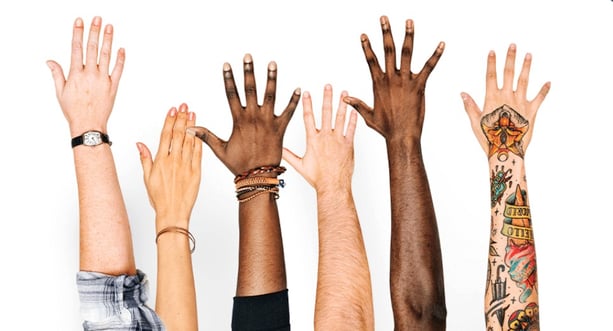SIGN UP FOR A
FREE GAME SHOW DEMO
Every Tuesday 11:00AM Pacific Time our world-class hosts put on a next level game show and Q&A session for you to try before you buy.
Diversity, equity, and inclusion (DEI) promotes the representation and participation of people of different ages, genders, religions, cultures, abilities, races, ethnicities, backgrounds, and sexual orientations. The term is used in the workplace to describe policies, programs, or activities that ensure all employees feel seen and supported.
The US is often called a melting pot…. but we’re more like a hearty vegetable soup. The different identities of the citizens of this country haven’t melted into one, but we do all swim around in the same stew. These unique identities, however, aren’t always represented proportionally—especially in the workplace. There are lots of reasons for this, but we’ll save that critical discussion for another day. DEI is important, if nothing else, because we’re trying to right this issue, and ensure everyone who makes up this society gets as fair a representation and opportunity as anyone else in the soup.
But if that isn’t enough to convince you, there’s also the fact that diversity leads to innovation. All scientists know that a diverse ecosystem is healthier and more resilient. The same is true in our society and organizations within our society. A diverse group of people in the workplace—and the diversity of ideas, customs, cultures, and perspectives that comes along with that—leads to an enriched exchange, and ultimately greater innovation. Who doesn’t want new and better ideas of how things could be done?
And just because you have diversity in the workplace doesn’t necessarily mean all people feel included. Have you ever been part of a group, but for some reason felt like you didn’t belong? Well, we’re not on the playground anymore, but people, particularly with minority identities, can often feel the same way in the workplace. The good news is, there are things we can do to make sure everyone feels more comfortable. Having everyone feel included will ensure that your company is a place that attracts diversity, where people with diverse identities want to be—and stay—because they feel included.
So, whether you’re new to DEI or not, here are a couple of questions to consider:
This may seem like a no brainer, but sometimes a little self-reflection and discovery is key. In asking this question, consider the types of diversity within your teams, and how DEI could be contextualized for individuals, teams, and your company at large.
As you look to expand your DEI initiatives, activities, and programs, be sure to consider the why in everything you do. Are you filling a quota, trying to make someone (or a group of people feel more supported and included), addressing systemic issues, or something else?
From recruiting and onboarding, to supporting and promoting, look at what you’re currently doing to support DEI. Also, look at your corporate culture and how that may be perceived by all members of your team.
 Once you assess how DEI is currently woven into your business, and the types of diversity within your teams, you can better ascertain the kinds of DEI activities that could offer the most value. For example, creating an activity to highlight aspects of diversity that are not reflected in your employee roster may not land well or resonate. (If you do a whole piece on women’s history, and your team is all men or predominantly men, there’s going to be a disconnect.) And providing an activity regarding a specific aspect of diversity and not others might make someone feel singled out. So, the key here is to read the room, find balance, and ensure everyone feels like they belong.
Once you assess how DEI is currently woven into your business, and the types of diversity within your teams, you can better ascertain the kinds of DEI activities that could offer the most value. For example, creating an activity to highlight aspects of diversity that are not reflected in your employee roster may not land well or resonate. (If you do a whole piece on women’s history, and your team is all men or predominantly men, there’s going to be a disconnect.) And providing an activity regarding a specific aspect of diversity and not others might make someone feel singled out. So, the key here is to read the room, find balance, and ensure everyone feels like they belong.
Because we all have our own biases, sometimes it can be hard to be truly objective in a situation or look at something from a place of objectivity. A good activity to help us break out of that way of thinking is to look at something commonplace and benign like a map or illustration and see how individuals identify any prejudices or inequities that may be at play. Is something bigger than the other? In a brighter color? What is in the center of the map or image? Why do you think certain decisions were made about how to prioritize information? Having your team all look at the same info and comment on it can help unify your team while also identifying the prevalence and prominence of bias in everything around us.
If you have a non-typical Caucasian name, it can often be hard to feel like you belong, especially when others consistently mispronounce your name. It’s also tiring to always speak up for yourself and correct others, especially superiors. So, a way to build inclusion and camaraderie around it is to play a name game.
Have team members share the story behind their names and any nicknames or preferred names they may have (or have had). To bring a bit more fun into It, you can have everyone come up with a rhyme about their name and name story, and then go around the virtual room and share them. This will help everyone feel more connected and ensure that you’re using the preferred name for each team member and pronunciation. Pro tip: this is also an amazing tool for larger teams if name recall is ever an issue. Not only will you remember their name, but you’ll also know their middle name, what it rhymes with, or why everyone in their family has a name beginning with a J.
Create a worksheet with a range of interests and activities. Have your team fill out the worksheet based on their perceptions of their teammates. Who do they think was a boy scout? On the honor roll? Can play the piano? Make sure the mix offers a variety of ideas, so people can not only recognize their own perceptions, but also learn a bit about their teammates as well. Trigger warning: if it’s not facilitated well, or your team isn’t ready for it, feelings can get hurt here. A safe place to start is to list interests and activities that aren’t connected to race, class, gender, sexual orientation, background, etc.

It’s always more impactful for a new initiative to be led by leadership when it comes to inclusion. Meet with your leadership team and identify ways that you can celebrate DEI in the workplace virtually. Perhaps it’s shifting your email signatures to include your pronouns and an inspirational quote by someone you admire. Maybe it’s starting a meeting by sharing your pronouns, or how you pronounce your name, or recognizing someone on your team that’s currently inspiring you.
A key aspect of DEI is to use the terminology that individuals of different backgrounds are using to refer to themselves. So, listen, and adapt, and then actually set a standard as to how to appropriately utilize language in a way that supports DEI. An interesting example is when the NYT decided to shift their standard to capitalizing Black in 2020. It was their first standard change of that magnitude in nearly a century, but reflective of their audience and climate, and acknowledging the power language and the written word holds on how information is seen and interpreted.
An ally is someone who supports groups or individuals who don’t come from the same place of privilege as the ally. Allyship is a way for individuals to collaborate and promote equity in the workplace through one-on-one relationships with team members and broader public advocacy. This is critical to the success of any DEI initiative and can enact substantive change when widely adopted. As you become an ally, it is imperative that you properly educate yourself, ask questions, and take your own experiences out of the picture as much as you can. It’s also important to own your privilege, even when it’s a hard pill to swallow. Then, you can start to bring diversity into the conversation more and offer support if someone is being marginalized.
For example, if you are a heterosexual person (a privileged identity in our society) and around a group of people making a bad joke about homosexuals, you can be an ally for homosexuals by speaking up and advocating for homosexuality, using your power as one who holds the privileged identity to make a change. In this way, the people of marginalized identity don’t always have to fend for themselves or educate others, which can be especially intimidating to do at work.
For allyship to be truly effective, it needs to be adopted by key leaders within your organization. Any DEI efforts made without it may not have the impact you’re looking for.
If someone is knowingly or unknowingly making someone feel excluded or unwelcome, it’s important to make sure they are held accountable for their actions. Acts of discrimination happen all the time, and unless someone (ideally everyone) stands up to them, the cycle perpetuates. So, for example, if someone mispronounces someone’s name on a regular basis, can your team step up and let that person know how the name in question is properly pronounced, and make sure they start to pronounce it correctly?
Microaggressions (actions or statements that discriminate and oppress marginalized groups in subtle, indirect, or unintentional ways) can be difficult to discern and identify, so it’s important to learn what they are and the harm they perpetuate. There are also macroaggressions, and outright prejudice and discrimination to be cognizant of as well.
Regardless of severity level, consider your company’s pathways of accountability, so that everyone—allies, and those who have experienced a harm themselves—have a way to air their grievances, receive support and acknowledgment, and pursue avenues of change within the team/organization in a safe way.
Creating an inclusive culture can feel messy, and not without its struggles and challenges. But as there are more processes in place, your teams know you are creating a culture of learning, growth and change, and everyone will feel more seen and safe.
Affinity groups or employee resource groups (ERG) are places where individuals who share common identity characteristics can gather, network, share, create, and support each other. These spaces can be extremely powerful, and help team members find and build community, receive guidance and mentoring, and offer a sense of safety and belonging. They can be virtual, in person, or a hybrid of the two, and have been shown to boost employee energy levels and provide more engaging and fulfilling work experiences. Since these are employee led, it’s important not to drive these, but rather offer resources, support, and managerial buy-in (and participation when appropriate) so your teams feel empowered to create, expand, and explore this space. And often, when one group is developed, others will come quickly after, so be prepared to scale and grow.
The first step to celebrating diversity is having diversity. Making a diverse workplace. Ensuring it is inclusive and equitable. Offering allyship and accountability. Which is no easy feat. And while you don’t want to run before you walk, as you gain strides in each of these areas, there are ways you can celebrate in the more traditional sense to bring a bit of lightness and camaraderie to your DEI initiatives. Here are a few ideas to try:

This interactive game highlights Black culture through a historic, pop culture, and fact-based lens. Learn about important figures and contributions from the Black community, test your knowledge, and have some fun.
Whether it’s Pride month, or your average Tuesday, this game includes trivia about important community leaders, a finish the lyrics activity with the greatest LGBTQ+ anthems, some background and trivia on Pride celebrations throughout the world, and an interactive piece to create art, memes, and play Pictionary.
We all know who really runs the world. This game highlights historical and modern female figures, politicians, entertainers, and other phenomenal women we look up to. There’s trivia, art challenges, and a musical component, so your team will not only learn about women’s contributions, they’ll have a ton of fun in the process.

However you choose to celebrate, promote, and support DEI in the workplace, it’s important to consider how DEI is currently woven into your business, the types of diversity within your teams, and what kinds of DEI activities could offer your employees the most value. And as you begin to broaden your DEI initiatives, continue to check in with your teams (and the climate) to identify new opportunities, areas of growth, and ways that everyone can feel a greater sense of belonging.
To book, please select the experience you're looking to schedule first
Select ExperienceEvery Tuesday 11:00AM Pacific Time our world-class hosts put on a next level game show and Q&A session for you to try before you buy.
